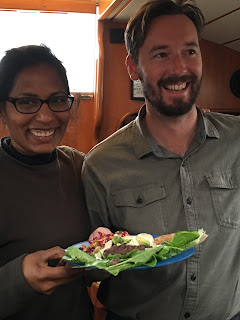We're staged to transit the Wrangell Narrows tomorrow by anchoring in Deception Point Cove tonight. These narrows are twenty miles long and likely to be full of commercial traffic. The rules of the game are to follow the navigation aids and chart closely, stay out of the shallows and out of the way of other traffic. Standard navigation really, just a lot of it. We'll proceed slowly and do our best, following a course set on the plotter while Frederic follows our position on the paper chart. The plotter has an identical (up to date) rasterized version of our (out of date) paper charts. Having the paper charts along gives us the comfort of redundancy in case something goes wrong with our electronics at the worst possible moment.
The chart plotter is not infallible. It spontaneously cycles power occasionally, requiring a minute or two to reboot, probably owing to an intermittent power connector on the back. I've also notice that there are some levels of chart detail that fail to update properly and leave the screen blank until we zoom in or out a level - a problem with the purchased map data. For the most part, however, the chart plotter has worked quite well and serves to get us from one anchorage to the next without any problems. Even so, it is prudent to have a healthy distrust of the technology.
Should the plotter stop working completely we also have a full suite of charts and a redundant gps on a laptop, the paper charts, and as a last resort, a hand held gps. The handheld gps uses the least amount of power, so it's the one that is always plugged in and serves to warn us during the night if the anchor moves.


